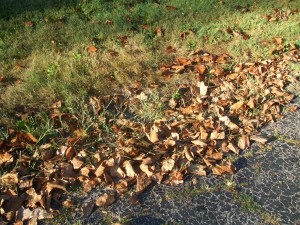
Improve dry, cracked soil with a layer of compost or other organic matter in fall and spring. © Jo Ellen Meyers Sharp
Indianapolis has just broken a 113-year-old record for the least amount of rainfall in August. Not since 1897 has it been so dry. Back then, .42 inches of rain fell. This year, the tally was .37.
For proof, check out the landscape.
A garden that has not been watered likely has soil that is dry and cracked. In one of my unmulched shrub borders, the cracks are wide and plentiful, even though the soil is excellent.
If that’s what your garden bed looks like, over the next several weeks, apply a layer of compost, rotted manure or chopped leaves about 2 inches deep. If desired, apply a light layer of shredded bark or other mulch. Water these plants deeply several times before the ground freezes, if we have a dry fall.

Leaves saturated with spring and early summer rains boiled in the dry heat of August. (C) Jo Ellen Meyers Sharp
Some trees and shrubs have already dropped their leaves, likely a sign of heat stress or scorch. It’s worse this year because in May and June, the heavy rains engorged leaf tissue with water, said Steve Mayer, a horticulture educator at the Marion County Extension Office.
With the long stretch of 90-degree days and no rain, the moisture-laden tissue broke down in the heat, turning brown, yellow or developing dark splotches between the leaf veins, he said.
There’s really no cure. However, making sure these stressed trees and shrubs are well watered going into winter will be important. Do not fertilizer trees and shrubs now.
If the grass is crispy, hold off applying the fall fertilizer in September, or reduce the rate by one-half. Avoid applying herbicides until the lawn is actively growing. An application of ½ inch of water every four weeks should protect the crowns of the grass plants.
[…] been soooo dry that the fruits were done early. I’ll remember this for next year. Usually we go in October […]